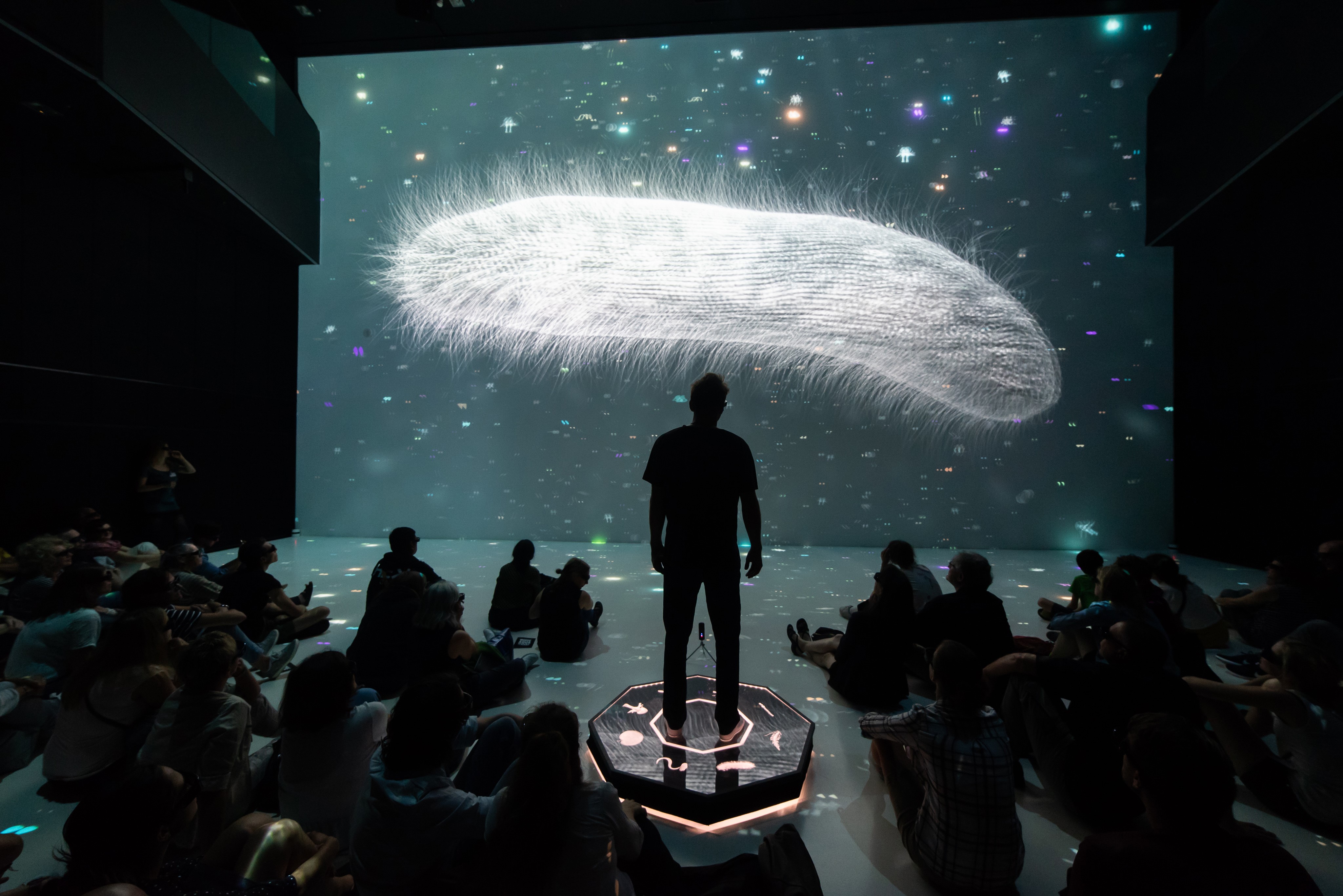Photo by Glenn Bristol
We’re often told to be conscious of our environmental impact and are reminded to consider the whales, turtles, and dolphins. But, how often do we consider the human effect on plankton? At SIGGRAPH 2019, Victoria Vesna and her team explored the larger impact of noise pollution on the environment with “Noise Aquarium,” an interactive installation. To better understand how the experience came to be, we sat down with Victoria to learn more about her inspiration, challenges, and how artists and researchers should be pivoting their work to adjust to COVID-19.
SIGGRAPH: Talk a bit about the process for developing your installation, “Noise Aquarium.” What inspired you to pursue this concept?
Victoria Vesna (VV): I have been interested in water, noise pollution, and micro/nano worlds for a long time. In 2001, I started collaborating with my partner, James Gimzewski, and together we’ve created many works that deal with the invisible — I’m particularly intrigued with the inaudible. We met Alfred Vendl in 2009 when he visited UCLA, and I later reconnected with him during my sabbatical when I was artist in residence at the Angewandte (University of Applied Arts) working on an ArtSci dinner project, Hox Zodiac.
Dr. Vendl has a background in chemistry and he migrated to filmmaking with a focus on micro-world visualizations. He was already renowned in the field of scientific visualization and received an Emmy for this work. In 2015, he started work with biologists who were scanning 3D models of plankton for Terence Malick’s “Voyage in Time,” which unfortunately were not used, but — fortunately for me — I was invited to create an artwork with these beautiful visualizations animated by Martina Fröschl, a Ph.D. student at that time who has since received her doctorate.
It took me a while to wrap my head around how to make this work, without just marveling at the beauty of these creatures, the impressive 3D scans by the biologists, or the amazing animations. I started researching and learning more about these amazing micro-creatures at the bottom of our food chain and my fascination grew exponentially. Since I have been always interested in underwater noise pollution, I wondered, “How does noise pollution affect the plankton?” When I approached scientists with this question, I was surprised to find that there was almost no research available, which I later understood is because of the complexity of the micro-creature ecology.
Reductionist methods simply do not work in these instances, but there is some speculation that the noise is fairly devastating to plankton, similar to how it affects other creatures. We know that dolphins and whales are very much impacted by anthropogenic noise, so I came up with the idea to blow up Martina’s animations to the size of whales and then worked with Paul Geluso on mixing and spatializing noise that I received from The Oceanographic Society.
SIGGRAPH: Your team seems very passionate about the environment and the impact humans have on the planet. How did you use this passion to develop this work?
VV: My work is always interdisciplinary, and, in the case of “Noise Aquarium,” this lent itself nicely. Additionally, most of the hands-on work was done by Martina, Glenn, and myself, and we are all very passionate about showing the beauty and complexity of this beautiful planet we live in. I have included this in my work since the beginning of my practice 30 years ago, and Martina is part of a climate change and art group that is a cooperation by the University of Salzburg Z_GIS and University of Applied Arts Vienna. I also actively teach this subject, curate shows — such as “Feminist Climate Change” at Ars Electronica — and, more recently, have co-organized a conference on art-based research in times of social and climate change.
SIGGRAPH: Let’s get technical. How did you develop this experience? How many people were involved? How long did it take?
VV: I started with a visualization to give the team an idea of how this would work — we would utilize the 3D scans that Martina animated, Glenn would program the interactive aspect, and I would work with Paul on the sound mixing and spatialization — and this is what we did. What happens is the person participating in the experience stands on the interactive pedestal (which is on top of a hacked Nintendo Wii Balance Board) and tries to balance themselves. Moving too much in either direction creates destruction of the plankton and brings up loud audio of one of the underwater noises. If perfectly centered and balanced, the plankton appears in front of the person and we hear the sound of the whales. For a moment, we can commune with the top of the food chain.
The work was initially a linear video that was to be projected on a large scale. We later worked on the interactive aspect using 3D glasses, which premiered at Ars Electronica, and finally Glenn programmed the VR version that allows a person to be fully immersed in the experience. This VR version is the experience we presented at SIGGRAPH 2019, which worked well since we were surrounded by other artworks utilizing sound.
For more detail on our scientific imaging techniques, you can take a look at our complete workflow.
The team was rather large and consisted of myself, Alfred Vendl, Martina Fröschl, Glenn Bristol, Paul Geluso, Stephan Handschuh, and Thomas Schwaha. If you count the research aspect, it took us a solid three years to complete this project.
SIGGRAPH: What was the biggest challenge?
VV: Noise! When we presented the experience, some places complained that the piece was too noisy. On the other hand, others wanted to present only the visuals, showing the beauty and erasing the destructive part that we generate.
SIGGRAPH: What do you find most exciting about the final project you exhibited in the SIGGRAPH 2019 Art Gallery?
VV: We were able to bring a group of high school students who were attending our SciArt summer program, and that was really fun. All of our instructors and the students suddenly understood the complexity of what we wanted to show — from the production to the experience, and, hopefully, this activated them to think about the environment differently. Plus, they got to see the entire exhibition, which was eye-opening for them.
We were also so excited and surprised to learn that Leonardo was hosting its celebration of 30 years at SIGGRAPH 2019, and “Noise Aquarium” was not only on the cover of the journal, but also on the birthday cake!
SIGGRAPH: What’s next for “Noise Aquarium”? How do you plan to continue fostering change and action?
VV: We’re working on adapting our plan due to COVID-19, as a lot of the shows we had planned are postponed or cancelled. Now, I am thinking about strategies to bring the experience to the home and share via personal networks. Glenn is a gamer, and we’ll lean on him for ideas as we move forward.
SIGGRAPH: Can you share your all-time favorite SIGGRAPH conference memory?
VV: My very first SIGGRAPH was in Chicago in 1992. This was such an exciting moment — I was lucky enough to be an intern at an animation company led by Stephanie Slade, whom I helped with her vision of creating a International Painting Interactive (IPI), which was the first collaborative video art wall to be networked. This was before the web, so we had to use ISDN, and I pulled in a lot of friends from my background in the video art world.
Over a hundred painters, video artists, graphic designers, and musicians in 14 cities around the world worked together for 44 hours, creating numerous digital paintings. In addition to participating in creating this, I had the opportunity to meet some of the great media artists who are now my colleagues and friends, including Perry Hoberman, Vibeke Sorensen, Ken Goldberg, Stephen Wilson, Jean Pierre-Hubert, and Char Davies. Most exciting of all, I got to experience the pioneering network art work of Kit Galloway and Sherrie Rabinowitz of Electronic Café International (ECI)!
The following year, I participated with my first interactive work, “Another Day in Paradise” in the Machine Culture exhibition curated by Simon Penny. Those two exhibitions were truly the beginning of my journey in connecting art, science, and technology.
SIGGRAPH: What advice do you have for someone looking to submit an interactive experience to a future SIGGRAPH conference?
VV: Due to COVID-19, my current answer differs from what I would have said a couple of months ago. Now, it’s more important than ever to think about how you can create innovative, interactive experiences online. A number of us worked in networked art in the mid ’90s to early 2000s, so there is a history there. At that time, a lot of the technology was not quite ready for some of the ideas that were out there, so it’s prudent to look back, pay homage, and take it to the next level. Examine how you can move Internet of Things, apps, and all that is familiar to new, creative ways of interaction that brings us closer together and somehow connects to our senses.
 Victoria Vesna is an Artist and Professor at the UCLA Department of Design Media Arts and Director of the Art|Sci Center at the UCLA School of the Arts and California NanoSystems Institute (CNSI). Born 1959 in Washington, D.C. to a diplomat from X Yugoslavia, she grew up in Indonesia, went to the High School of Art and Design in New York City, got her degree from the University of Fine Arts in Belgrade, Serbia, and received her Ph.D. at the University of Wales in the United Kingdom under the supervision of Roy Ascott.
Victoria Vesna is an Artist and Professor at the UCLA Department of Design Media Arts and Director of the Art|Sci Center at the UCLA School of the Arts and California NanoSystems Institute (CNSI). Born 1959 in Washington, D.C. to a diplomat from X Yugoslavia, she grew up in Indonesia, went to the High School of Art and Design in New York City, got her degree from the University of Fine Arts in Belgrade, Serbia, and received her Ph.D. at the University of Wales in the United Kingdom under the supervision of Roy Ascott.
With her installations she investigates how communication technologies affect collective behavior and perceptions of identity shift in relation to scientific innovation. Her work involves long-term collaborations with composers, nano-scientists, neuroscientists, and evolutionary biologists, and she brings this experience to students. Victoria has exhibited her work in 20+ solo exhibitions and 70+ group shows, has been published in 20+ papers, and has given 100+ invited talks in the last decade. Her work has always centered on environmental and social issues, and she often hosts symposia and exhibitions that address climate change. Most recently, she curated exhibitions titled “Feminist Climate Change” — for both the UCLA campus and Ars Electronica 2018 — and “Art Based Research in Times of Climate Change” in collaboration with the Angewandte Wien, 2019.
Victoria is the North American editor of AI & Society journal (Springer Verlag, UK) and in 2007 published an edited volume — Database Aesthetics: Art in the Age of Information Overflow (Minnesota Press) — and another in 2011 — Context Providers: Conditions of Meaning in Media Arts. (co-edited with Christiane Paul and Margot Lovejoy) Intellect Ltd, 2011. Currently she is working on a series of books “Art Science & Technology” based on her online lecture class and the Hox Zodiac cookbook: genetic engineering and animals. (2020)



